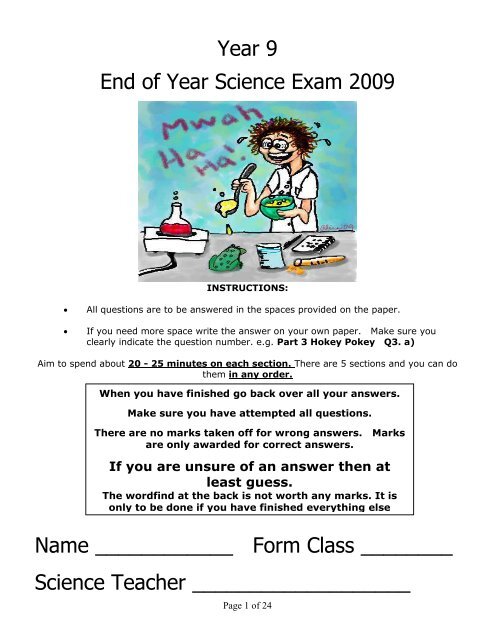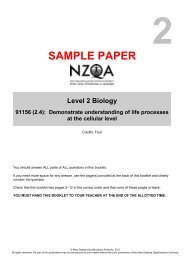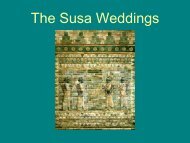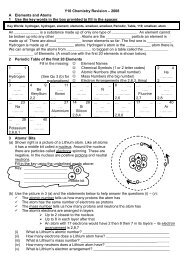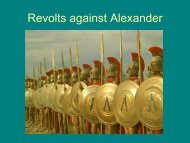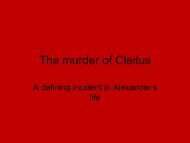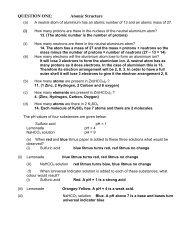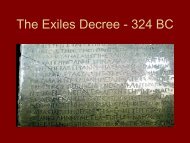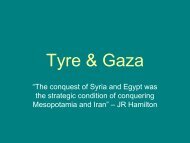Year 9 2009 Exam
Year 9 2009 Exam
Year 9 2009 Exam
You also want an ePaper? Increase the reach of your titles
YUMPU automatically turns print PDFs into web optimized ePapers that Google loves.
<strong>Year</strong> 9<br />
End of <strong>Year</strong> Science <strong>Exam</strong> <strong>2009</strong><br />
INSTRUCTIONS:<br />
<br />
<br />
All questions are to be answered in the spaces provided on the paper.<br />
If you need more space write the answer on your own paper. Make sure you<br />
clearly indicate the question number. e.g. Part 3 Hokey Pokey Q3. a)<br />
Aim to spend about 20 - 25 minutes on each section. There are 5 sections and you can do<br />
them in any order.<br />
When you have finished go back over all your answers.<br />
Make sure you have attempted all questions.<br />
There are no marks taken off for wrong answers. Marks<br />
are only awarded for correct answers.<br />
If you are unsure of an answer then at<br />
least guess.<br />
The wordfind at the back is not worth any marks. It is<br />
only to be done if you have finished everything else<br />
Name ____________ Form Class ________<br />
Science Teacher ___________________<br />
Page 1 of 24
Time allowed 1 hour and 45 minutes.<br />
The paper is divided into 5 sections. Spend about 20 to 25 minutes on each Section.<br />
Write answers in the spaces provided<br />
Part 1: Introduction to Science<br />
Question 1<br />
A B C D E<br />
(a)<br />
F G H I J<br />
Name the pieces of laboratory equipment drawn above. (H has been done for you.)<br />
A ________________________ F ________________________<br />
B ________________________ G ________________________<br />
C ________________________ H Stirring rod<br />
D ________________________ I ________________________<br />
E ________________________ J ________________________<br />
b) Write the letter(s) of the piece or pieces of equipment you would use to<br />
i)<br />
ii)<br />
filter sand and water<br />
measure the volume of a small stone<br />
________________________.<br />
________________________.<br />
iii)<br />
iv)<br />
evaporate a solution of salt and water ________________________.<br />
boil water and measure its temperature ________________________.<br />
v)<br />
dissolve salt in water<br />
________________________.<br />
Page 2 of 24
Question 2<br />
Energy Equations<br />
Below are five pictures. For each one write an energy equation. (a) is done for you.<br />
a)<br />
Energy equation for electric lamp<br />
Electrical Energy → Light energy + heat energy<br />
b)<br />
Energy equation for petrol car going up hill<br />
c)<br />
Energy equation for skateboarder going down hill<br />
d)<br />
Energy equation for bungy jump just after leaving the<br />
platform all the way to the bottom<br />
e)<br />
Energy equation for ipod playing music<br />
Question 3 Practicals<br />
Results Aim Conclusion Hypothesis Method<br />
Put the above terms into the order they go when you write up a practical:<br />
Page 3 of 24
Write each term (Conclusion, Hypothesis, Aim, Results, Method) next to its correct definition:<br />
Section Name<br />
Definition<br />
a) This is what you hope to prove<br />
b) What you saw happen and or what you<br />
measured<br />
c) This is what you think will happen<br />
d) Clear step by step instructions on what to do<br />
e) An explanation of the results that relates<br />
back to aim<br />
Question 4. Tom races his trolley down a hill. The table below gives the distances the trolley travelled from<br />
the start line.<br />
Time (sec) 0 1 2 3 4 5 6 7 8<br />
Distances (m) 0 2.6 ? 8.0 10.7 12.0 14.5 17.0 19.5<br />
a) Plot this data as a line graph on the grid below.<br />
b) From the graph, what is the distance the trolley has travelled after 2 seconds? __________<br />
metres<br />
Page 4 of 24
c) Discuss why you light a Bunsen with the air hole closed, but then you heat an object with<br />
the air hole open.<br />
____________________________________________________<br />
____________________________________________________<br />
____________________________________________________<br />
____________________________________________________<br />
____________________________________________________<br />
____________________________________________________<br />
____________________________________________________<br />
____________________________________________________<br />
____________________________________________________<br />
____________________________________________________<br />
Part 2:<br />
Close Up Look at Food Chains.<br />
Objective: To understand factors that affect habitat and communities.<br />
1. List 5 different environmental factors that could affect this bird.<br />
(i)<br />
(ii)<br />
(iii)<br />
(iv)<br />
(v)<br />
_______________________________________________<br />
_______________________________________________<br />
_______________________________________________<br />
_______________________________________________<br />
_______________________________________________<br />
Page 5 of 24
Objective: To discuss adaptations of organisms.<br />
2. Look at the picture of a seagull. Write down three adaptations it has. For excellence you need to give one<br />
adaptation from each of the three types<br />
For each adaptation explain how it helps the seagull survive.<br />
(a)<br />
Adaptation<br />
How it helps the seagull to survive.<br />
(b)<br />
(c)<br />
3. Objective: To know how to use a biological key<br />
These are all New Zealand native creatures. Use the identification key on the next page to answer the<br />
questions.<br />
Page 6 of 24
STEP 1<br />
STEP 2<br />
STEP 3<br />
STEP 4<br />
STEP 5<br />
(i) wings<br />
(ii) no wings<br />
(i) wings project sideways<br />
(ii) wings do not project sideways<br />
(i) hind legs extend beyond body<br />
(ii) hind legs do not extend beyond body<br />
(i) wings cover abdomen completely<br />
(ii) wings do not cover all of abdomen<br />
(i) six legs<br />
(ii) eight legs<br />
Go to Step 2<br />
Go to Step 5<br />
Go to Step 3<br />
Go to Step 4<br />
Cranefly<br />
Hunter wasp<br />
Shield-bug<br />
Bluebottle<br />
Earwig<br />
Leaping spider<br />
a) What is Creature V? ____________________<br />
b) Which creature is a cranefly? __________<br />
c) From the key work out how many creatures have wings. __________<br />
d) Which creature has wings which cover the whole abdomen and wings that do not project<br />
sideways? ____________________<br />
e) What are the characteristics of a leaping spider?<br />
_________________________________________________________________<br />
_________________________________________________________________<br />
f) Discuss why keys are mainly based on the physical appearance of the animal.<br />
____________________________________________________<br />
____________________________________________________<br />
____________________________________________________<br />
____________________________________________________<br />
____________________________________________________<br />
____________________________________________________<br />
____________________________________________________<br />
____________________________________________________<br />
Page 7 of 24
Objective: To know the parts of a microscope.<br />
4. (i) Label the parts of this microscope<br />
Part<br />
A<br />
Name of Part<br />
A<br />
B<br />
B<br />
C<br />
D<br />
C<br />
E<br />
D<br />
F<br />
E<br />
F<br />
(ii) On this microscope Part A had x15 marked on it. Part D had x4 marked on it. How much does this<br />
microscope enlarge the image if these two parts are being used at the same time.<br />
_________________________________________________________________________<br />
(iii) A student put the letter p the correct way up under a microscope.<br />
Draw what the student would see when they looked down the microscope in the box provided.<br />
Objective: To know the characteristics of living things.<br />
All living things have 8 features in common which can be represented with the words MRS C GREN.<br />
a) Complete the spaces below to give the features. One is done for you.<br />
M_____________ R_____________ S _____________<br />
Cells G_____________ R_____________<br />
E_____________ N_____________<br />
b) David goes to eat an apple. He says it is not alive. His friend Sarah says it is dead. Explain which of them is correct.<br />
____________________________________________________<br />
____________________________________________________<br />
____________________________________________________<br />
____________________________________________________<br />
____________________________________________________<br />
Page 8 of 24
Objective: To understand food chains and food webs.<br />
Here is a food web from the sea.<br />
tiny plants<br />
tiny animals<br />
mussel<br />
fish<br />
periwinkle<br />
seal<br />
seaweed<br />
starfish<br />
limpet<br />
crab<br />
seagull<br />
5. Use the food web above to answer the following questions.<br />
a) Complete this food chain by filling in the missing link.<br />
seaweed _______________ starfish<br />
b) What eats periwinkle? ____________________<br />
c) How many different foods does the fish eat? __________<br />
d) Why do food chains start with a producer?<br />
____________________________________________________<br />
____________________________________________________<br />
e) Draw the food chain from the food web with the greatest number of links.<br />
____________________________________________________<br />
f) Discuss the effect on the food chain of the removal of the starfish.<br />
____________________________________________________<br />
____________________________________________________<br />
____________________________________________________<br />
____________________________________________________<br />
____________________________________________________<br />
____________________________________________________<br />
____________________________________________________<br />
Page 9 of 24
Objective: To be able to distinguish between animal and plant cells.<br />
6. Below are two diagrams of cells. One is a plant cell while the other is an animal cell. In the space<br />
provided write down what type of cell each one is.<br />
Type of cell: __________________________ Type of cell: _______________________<br />
Cell 1 Cell 2<br />
A<br />
B<br />
C<br />
D<br />
ii<br />
i<br />
E<br />
F<br />
iii<br />
Write the names of the labelled parts of each cell in the boxes below.<br />
A<br />
B<br />
C<br />
D<br />
E<br />
F<br />
7. Discuss the differences between a plant cell and an animal cell and relate them to the use of each cell.<br />
____________________________________________________<br />
____________________________________________________<br />
____________________________________________________<br />
____________________________________________________<br />
____________________________________________________<br />
____________________________________________________<br />
____________________________________________________<br />
____________________________________________________<br />
____________________________________________________<br />
i<br />
ii<br />
iii<br />
Page 10 of 24
Part 3:<br />
Hokey Pokey<br />
Question 1:<br />
Write the chemical symbol for the following:<br />
Hydrogen _______ Lithium _________ Calcium __________<br />
Silicon _________ Potassium _______ Magnesium ________<br />
Write the full name for the following:<br />
S ______________ O _______________ Na _______________<br />
B ______________ C _______________ Al ________________<br />
Question 2:<br />
Write the full name for the following:<br />
CO 2 ___________________________<br />
HCl ___________________________<br />
H 2 O _______________________<br />
NaCl ______________________<br />
Write the formulae for the following:<br />
Copper sulphate __________________<br />
Sulphuric acid _______________<br />
Question 3: Gas tests: In this topic you tested for three important gases. Complete the table<br />
Name of gas Description of<br />
the gas.<br />
Carbon<br />
dioxide<br />
Formula Name of the test for the gas AND<br />
what happens if the test is positive<br />
H 2<br />
Oxygen gas<br />
Page 11 of 24
Question 4: Write a sentence to define the following:<br />
Element_______________________________________________<br />
____________________________________________________<br />
Compound _____________________________________________<br />
____________________________________________________<br />
Mixture _______________________________________________<br />
____________________________________________________<br />
The following substances are elements, compounds or mixtures.<br />
b) Write them into the correct column in the table below.<br />
Tap Water gold Seawater oxygen paint<br />
Sand copper salt tin steel<br />
Baking soda<br />
sugar<br />
Element Compound Mixture<br />
Question 5. The pictures below show a change in state.<br />
Name the change in state and indicate whether energy is being added or removed.<br />
A wet swimmer drying in the sun<br />
Name __________________<br />
Energy __________________<br />
Dew forming on the grass<br />
Name __________________<br />
Energy __________________<br />
An iceblock in the sun<br />
Name __________________<br />
Energy __________________<br />
mist coming out the exhaust of a car<br />
Name __________________<br />
Energy __________________<br />
Page 12 of 24
Question 6.<br />
a) Write a paragraph to explain what happens to the water particles as a puddle evaporates.<br />
____________________________________________________<br />
____________________________________________________<br />
____________________________________________________<br />
____________________________________________________<br />
____________________________________________________<br />
____________________________________________________<br />
____________________________________________________<br />
b) Discuss what is similar and what is different between a solid and a liquid in terms of the<br />
particles in them.<br />
____________________________________________________<br />
____________________________________________________<br />
____________________________________________________<br />
____________________________________________________<br />
____________________________________________________<br />
____________________________________________________<br />
____________________________________________________<br />
____________________________________________________<br />
Question 7.<br />
In class you saw sherbert being made and got to taste it. Making sherbert involved citric acid<br />
and baking soda (which contains carbonate)<br />
a) Explain why the sherbert did not fizz in the bag, but did fizz in your mouth.<br />
____________________________________________________<br />
____________________________________________________<br />
____________________________________________________<br />
____________________________________________________<br />
____________________________________________________<br />
____________________________________________________<br />
b) What gas was given off with the sherbert reaction?<br />
____________________________________________________<br />
Page 13 of 24
Question 8: During this topic you reacted many chemicals. Complete the following table.<br />
Name of the Reactants Name of ONE Product ONE observation for each reaction<br />
Magnesium and oxygen<br />
Magnesium and<br />
hydrochloric acid<br />
Baking soda and<br />
vinegar<br />
Question 9: Acids and Bases and the pH scale.<br />
(a) Count the number of atoms in the following molecules.<br />
KCl ___________ Na 2 CO 3 ___________ MgCl 2 ______________ _________<br />
(b) Litmus paper, Universal test paper and universal indicator are used to tell us the pH of a<br />
solution. Complete the following table writing in the colour the paper / indicator would turn for<br />
the solutions given.<br />
Solution Red Litmus Blue Litmus UTP/Universal indicator<br />
Tap water<br />
acid<br />
Base<br />
Question 10: The picture below shows a jelly. In making the jelly there is a solvent, solute and a<br />
solution. Name each:<br />
Solvent:<br />
Solute:<br />
Solution:<br />
Page 14 of 24
Part 4:<br />
1.<br />
Light<br />
a) Circle the names of all the things below that are a source of light.<br />
Sun mirror candle stars torch moon<br />
b) Explain what is meant by a source of light.<br />
____________________________________________________<br />
____________________________________________________<br />
____________________________________________________<br />
____________________________________________________<br />
C) Fill in the missing angles when light reflects off a mirror.<br />
d) Draw in the image of the letter in the mirror to show how it would look<br />
Mirror<br />
y<br />
Page 15 of 24
e) Complete these ray diagrams, drawing in light rays with arrows to show direction of arrows after they<br />
pass through the lens.<br />
Clearly label the Focus (Focal Point) if appropriate<br />
(ii)<br />
g) Definitions Select the correct definitions from the list to match with the statements in the table<br />
below. Write the word in the correct place on the table.<br />
List; Transparent, Opaque, Reflection, Refraction, Focus (Focal Point), Normal<br />
Write down the name of the part that matches these definitions below<br />
Word<br />
Definition<br />
When light rays bounce off an object<br />
The point where a lot of light rays meet<br />
An imaginary line at right angles to a mirror<br />
Means light will pass through<br />
When light rays bend passing from one substance to another<br />
Means light will not pass through<br />
Page 16 of 24
The Human Eye<br />
2 a) Here is a diagram of the Human eye.<br />
E<br />
D<br />
A<br />
B<br />
C<br />
Write down the names of the parts A-E in the table below.<br />
Letter Name of part<br />
b) Write down the name (or number) of the part that matches these definitions below<br />
(i) The part that focuses light onto the Retina _______________<br />
(ii) The part that controls the amount of light entering the eye _______________<br />
(iii) The part that carries messages about light to the brain _______________<br />
(iv) The part that contains light sensitive cells that detect light _______________<br />
c) Explain why your eye has a blindspot.<br />
____________________________________________________<br />
____________________________________________________<br />
____________________________________________________<br />
____________________________________________________<br />
____________________________________________________<br />
____________________________________________________<br />
Page 17 of 24
A X B<br />
Focus.<br />
3. <strong>Exam</strong>ine the picture of the mirror above<br />
(i) Is it a concave or convex mirror? ________________________<br />
(ii) Draw in lines to show how the rays are reflected.<br />
(iii) Explain how the image would change when viewed from A and then from B<br />
____________________________________________________<br />
____________________________________________________<br />
____________________________________________________<br />
____________________________________________________<br />
4. Draw a diagram in the space below to show how a periscope works<br />
Include labelled<br />
Mirrors<br />
Light rays<br />
Object<br />
eye<br />
Page 18 of 24
5. Colours<br />
(a) Write down the 7 colours in a rainbow.<br />
____________________________________________________<br />
____________________________________________________<br />
(b) Name the triangular object that separates colours in white light to give a rainbow effect.<br />
_____________________<br />
(c) Discuss why a blue object looks blue in white light (You may wish to draw a diagram)<br />
____________________________________________________<br />
____________________________________________________<br />
____________________________________________________<br />
____________________________________________________<br />
____________________________________________________<br />
____________________________________________________<br />
____________________________________________________<br />
____________________________________________________<br />
____________________________________________________<br />
(d) in blue light, what colour would a i) Blue object look? ______________________<br />
ii) Red object look? ______________________<br />
Page 19 of 24
Part 5:<br />
Space<br />
QUESTION ONE: SOLAR SYSTEM<br />
(a) Describe what the rotation time (day) for a planet means.<br />
___________________________________________________________________________<br />
___________________________________________________________________________<br />
(b)<br />
(c)<br />
Name the largest planet in our solar system ____________________________<br />
Describe the difference between planets and moons.<br />
___________________________________________________________________________<br />
___________________________________________________________________________<br />
___________________________________________________________________________<br />
(d)<br />
Explain how tides are produced. Include a diagram in the space provided to illustrate your<br />
explanation.<br />
____________________________________________________<br />
____________________________________________________<br />
____________________________________________________<br />
____________________________________________________<br />
____________________________________________________<br />
Page 20 of 24
An equinox is when day and night are of equal length. There are two equinoxes in a year. One equinox<br />
occurs in spring, and the other in autumn.<br />
(e) Use the position and movement of the Earth as it moves around the sun to discuss how and why<br />
the two equinoxes occur. Use the space below for a diagram.<br />
QUESTION THREE: SPACE EXPLORATION<br />
____________________________________________________<br />
____________________________________________________<br />
____________________________________________________<br />
____________________________________________________<br />
____________________________________________________<br />
____________________________________________________<br />
(f)<br />
Describe one effect of weightlessness on the human body when travelling in space.<br />
____________________________________________________<br />
____________________________________________________<br />
Page 21 of 24
(h)<br />
Name TWO uses for satellites that orbit the Earth.<br />
____________________________________________________<br />
____________________________________________________<br />
QUESTION TWO: MOONS<br />
(a)<br />
Explain what causes an eclipse of the Moon (Lunar eclipse). A diagram should be included in the<br />
space provided below.<br />
____________________________________________________<br />
____________________________________________________<br />
____________________________________________________<br />
____________________________________________________<br />
____________________________________________________<br />
(b)<br />
The following diagram illustrates the phases of the Moon.<br />
(c) What do the terms waxing and waning (used in the diagram above) mean?<br />
____________________________________________________<br />
____________________________________________________<br />
____________________________________________________<br />
Page 22 of 24
(d) Discuss the cause of the Moon’s phases. Use the space below to draw a diagram to help show your<br />
understanding.<br />
____________________________________________________<br />
____________________________________________________<br />
____________________________________________________<br />
____________________________________________________<br />
____________________________________________________<br />
____________________________________________________<br />
____________________________________________________<br />
(e)<br />
Name ONE planet, other than the Earth, that has moons.<br />
______________________________<br />
QUESTION THREE: DISTANCES IN SPACE<br />
(a) Write down the letters placing the statements in order from the shortest distance to the longest<br />
distance<br />
A. Earth to Mars<br />
B. Earth to the Southern Cross<br />
C. Earth to Saturn<br />
D Earth to Moon<br />
Shortest<br />
Longest<br />
Page 23 of 24
(b) Explain the term LIGHT YEAR in terms of distance in space<br />
____________________________________________________<br />
____________________________________________________<br />
____________________________________________________<br />
____________________________________________________<br />
____________________________________________________<br />
Page 24 of 24


